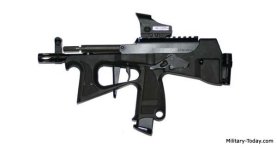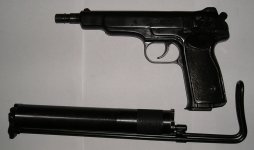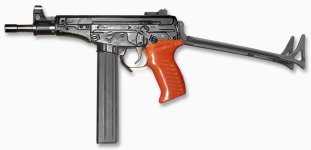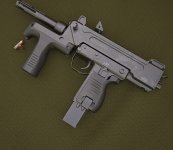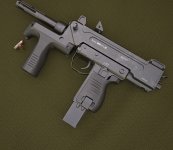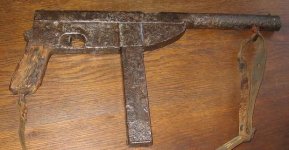You are using an out of date browser. It may not display this or other websites correctly.
You should upgrade or use an alternative browser.
You should upgrade or use an alternative browser.
What the heck
- Thread starter Ozzieman
- Start date
StraightOuttaAmmo
Inactive
Russian PP-2000 
Lefever or Union Revolver
Well, contesting it and proving it are often not related. But I offer this:
But I offer this:
Here is a YouTube of a Union being demonstrated. Note the similarity.
https://m.youtube.com/watch?v=L7K3nfH8cK0
Here is an identified Zulaica. http://guns.wikia.com/wiki/Zulaica_automatic_revolver
Note the difference on the upper frame.
Lastly, here is a Lefever:
http://guns.wikia.com/wiki/Lefever_automatic_revolver.
Thoughts?
Well, contesting it and proving it are often not related.
Here is a YouTube of a Union being demonstrated. Note the similarity.
https://m.youtube.com/watch?v=L7K3nfH8cK0
Here is an identified Zulaica. http://guns.wikia.com/wiki/Zulaica_automatic_revolver
Note the difference on the upper frame.
Lastly, here is a Lefever:
http://guns.wikia.com/wiki/Lefever_automatic_revolver.
Thoughts?
Last edited:
Relod'n is correct.
It appears to be closer to the Lefever. Sorry for the error
He proves it with this
https://m.youtube.com/watch?v=L7K3nfH8cK0
It appears to be closer to the Lefever. Sorry for the error
He proves it with this
https://m.youtube.com/watch?v=L7K3nfH8cK0
StraightOuttaAmmo Good catch.
198 PP-2000
https://en.wikipedia.org/wiki/PP-2000
The PP-2000 (Russian: ПП-2000) is a submachine gun made by the KBP Instrument Design Bureau. It was first publicly displayed at the Interpolytech-2004 exhibition in Moscow even though its patent was filed in 2001 and issued in 2003.[3]
Overview[edit]
The PP-2000 is a conventional blowback-operated weapon and weighs 1.5 kg (3.3 lb) empty. The PP-2000 is designed as a close-quarter combat weapon, intended for riot police and special operations forces. In 2008, it was adopted as one of the two standard SMGs of the Russian police (along with the Vityaz-SN).[5]
Design[edit]
It is chambered in 9×19mm Parabellum, and specifically designed to utilize the new Russian 9×19mm 7N21 and 7N31 (Cyrillic: 7Н21 and 7Н31) +P+ armor-piercing versions of the cartridge. This is intended to give the PP-2000 armor-piercing capability comparable to the FN P90 and Heckler & Koch MP7 personal defense weapons while also being able to use common 9mm Parabellum rounds.
One unusual feature is the ability to store a spare 44-round magazine at the rear of the gun, where it also functions as a stock. A wire folding stock is also available. Another unusual feature is that this firearm's charging handle is located directly behind the front sight and folds out of the way when not in use. A similar folding charging handle can be seen on the Heckler & Koch G36.
198 PP-2000
https://en.wikipedia.org/wiki/PP-2000
The PP-2000 (Russian: ПП-2000) is a submachine gun made by the KBP Instrument Design Bureau. It was first publicly displayed at the Interpolytech-2004 exhibition in Moscow even though its patent was filed in 2001 and issued in 2003.[3]
Overview[edit]
The PP-2000 is a conventional blowback-operated weapon and weighs 1.5 kg (3.3 lb) empty. The PP-2000 is designed as a close-quarter combat weapon, intended for riot police and special operations forces. In 2008, it was adopted as one of the two standard SMGs of the Russian police (along with the Vityaz-SN).[5]
Design[edit]
It is chambered in 9×19mm Parabellum, and specifically designed to utilize the new Russian 9×19mm 7N21 and 7N31 (Cyrillic: 7Н21 and 7Н31) +P+ armor-piercing versions of the cartridge. This is intended to give the PP-2000 armor-piercing capability comparable to the FN P90 and Heckler & Koch MP7 personal defense weapons while also being able to use common 9mm Parabellum rounds.
One unusual feature is the ability to store a spare 44-round magazine at the rear of the gun, where it also functions as a stock. A wire folding stock is also available. Another unusual feature is that this firearm's charging handle is located directly behind the front sight and folds out of the way when not in use. A similar folding charging handle can be seen on the Heckler & Koch G36.
mapsjanhere
New member
Russian silenced APB 6P13
Well mapsjanhere at least it lasted 10 min.
Good catch
210 Stechkin automatic pistol
https://en.wikipedia.org/wiki/Stechkin_automatic_pistol
The Stechkin automatic pistol or APS (Avtomaticheskiy Pistolet Stechkina, Russian: Автоматический Пистолет Стечкина) is a Soviet selective fire machine pistol. It bears the name of its developer, Igor Stechkin.
Adoption and service[edit]
Submachine guns such as the PPSh-41 or the PPS-43 were declared obsolete shortly after the adoption of the AK47 assault rifle. A new self-defence weapon was requested for artillery and mortar crews, tank crews and aircraft personnel, where a cumbersome assault rifle was deemed unnecessary.
Igor Yakovlevich Stechkin, recently graduated in 1948 from the Tula Mechanical Institute, began work on this new automatic weapon concept, competing against other prolific designers such as Vojvodin and Kalashnikov. Stechkin designed a select-fire pistol capable of accurate fire up to 200 meters, with the possibility of attaching a combination holster/shoulder stock. Field-testing of the first prototypes was undertaken from April to June 1949. A 20000 round endurance test against an Astra machine pistol, and a PPS-43 submachine gun proved that Stechkin's design was promising. However, the testing board showed flaws of the prototype, such as the lack of adjustability of the rear sight, the high weight (1.9 kg with holster), short sight radius, and the recoil spring located under the barrel.
A large redesign effort was made by Stechkin. He took several inspirations from the Makarov pistol, such as the general silhouette, slide rails, extractor. The gun was lightened, the trigger mechanism redesigned and simplified, and the trigger guard reshaped. After successful military tests, the APS was formally adopted on the 3rd of December, 1951.
The APS was issued to Red Army vehicle operators, artillery crew, and front-line officers and law enforcement, and was used in conflicts in Angola, Libya, Mozambique, Romania, Tanzania and Zambia. The APS was praised for its innovative concept and good controllability for its size. However, the high cost of the weapon, complex and time-consuming machining, combined with a limited effective range, large size and weight for a pistol, fragile buttstock, frequent stoppages and subpar ergonomics, led to the APS being gradually phased out of active service. However, the weapon found a new niche among special forces such as the Spetsnaz or FSB, who needed a more effective sidearm than the Makarov PM. The Stechkin APS was eventually replaced[citation needed] by the AKS-74U compact assault rifle in 1981, offering more firepower due to its much more powerful 5.45×39mm M74 rifle ammunition, acceptable accuracy at moderate distances, and greater magazine capacity.
A contemporary derivative of the Stechkin, the OTS-33 Pernach, is also chambered for the 9×18mm Makarov cartridge.
Design details[edit]
The APS is a straight-blowback, select-fire, magazine-fed machine pistol. The weapon is fed through 20-round double-stack double-feed detachable steel box magazines. The APS shares common features with the Makarov service pistol, such as a heel-mounted magazine release, slide-mounted safety lever, and field-strip procedure. The rear sight is adjustable from 25, 50, 100 to 200 meters through an eccentric rotating drum/dial. The serrated front sight may be drifted for windage. The slide featured a textured strip on top to reduce aim-disturbing glare. The chrome-lined barrel serves as the recoil spring guide. The slide stop lever also acts as an ejector blade. The trigger guard pivots down for stripping and detents in position through a spring-loaded plunger. The checkered or serrated grips panels are made from wood (early models), reddish-brown bakelite or black plastic.
The Stechkin features a combination safety/decocker/fire selector lever on the slide. The three-position lever, when pointed forward in the "PR" or safe position, decocks and locks the hammer, locks the slide to the frame and prevents forward travel of the free-floating firing pin. When pointed downwards to the "OD", or single-shot position, the safety lever deactivates the auto-sear and rate reducer to allow semi-automatic fire. Finally, the rearmost "AVT" position puts the APS in fully automatic mode.
The trigger mechanism of the APS is of a simple construction and features a double/single-action fire mode. It comprises a trigger and trigger bar, disconnector, sear and hammer. The rebounding hammer, when in resting state, has an intermediate safety intercept notch that does not allow forward travel of the hammer unless the sear is raised. Disconnection is achieved through a cam in the slide.
To make controllable automatic fire possible through such a platform, designer Stechkin employs several mechanical solutions. Firstly, the slide has a very long stroke (three times the length of the cartridge). This allows time to slow the slide down and reduce felt recoil by minimising the jolt produced through the collision of the slide with the frame. Secondly, the rate-reducer lever offers extra resistance to the opening stroke of the slide, further slowing down the cycling process. Finally, the primary inertial rate reducing plunger delays the dropping of the hammer after the slide closes. The slide has a large cam that strikes a lever downwards. This lever transfers that energy to a spring-loaded weight located in the grip. The weight travels down, compressing its spring, then slams back up into the trigger bar, tripping the sear and firing the gun. Effectively, the rate reducer, which reduced the automatic rate of fire from 1000 RPM to 750RPM, also acts as the auto-sear.
The machine pistol may be fitted with a wooden (early), brown bakelite or steel wire shoulder stock (for the APB variant); otherwise, the weapon becomes difficult to control on full auto. The stock is attached via a T-slot cut into the rear strap of the pistol frame. The stock is hollowed out and can act as a holster, accepting the machine pistol inside, similar to the Mauser C96 pistol.
APB silent variant[edit]
The APB (Avtomaticheskij Pistolet Besshumnyj, meaning automatic silenced pistol) version was a version of the APS optimized for silent operations. Developed in the early 1970s by A.S. Neugodov (А.С. Неугодов) under the factory name AO-44, it was officially adopted in 1972 under the service name APB and given GRAU index 6P13. Approximately 2000 APS pistols were converted to APB variants by the Vyatskie Polyansky Machine-Building Plant from 1972 to 1973. Muzzle velocity reportedly dropped to 290 m/s in this variant.[2] Instead of the holster-stock of the APS, the APB comes with a detachable stock made of steel wire. Its barrel is longer than that of the APS; it protrudes from the slide and is threaded for the attachment of an eccentric sound suppressor. The barrel itself is also wrapped around by an integrated expansion chamber, in which gasses escape from holes in the barrel. When not in use, the detachable sound suppressor can be clipped to the stock.[3]
During the Soviet war in Afghanistan, the APB was used by Soviet Spetsnaz team leaders as an extra weapon; they usually carried on a sling with the suppressor and stock mounted. It was also employed by radio operators and even by some heavy gun crews.[3]
In the more recent past, other special forces units of the MVD such as the OMON and the SOBR have also been equipped with this pistol.[citation needed]
Good catch
210 Stechkin automatic pistol
https://en.wikipedia.org/wiki/Stechkin_automatic_pistol
The Stechkin automatic pistol or APS (Avtomaticheskiy Pistolet Stechkina, Russian: Автоматический Пистолет Стечкина) is a Soviet selective fire machine pistol. It bears the name of its developer, Igor Stechkin.
Adoption and service[edit]
Submachine guns such as the PPSh-41 or the PPS-43 were declared obsolete shortly after the adoption of the AK47 assault rifle. A new self-defence weapon was requested for artillery and mortar crews, tank crews and aircraft personnel, where a cumbersome assault rifle was deemed unnecessary.
Igor Yakovlevich Stechkin, recently graduated in 1948 from the Tula Mechanical Institute, began work on this new automatic weapon concept, competing against other prolific designers such as Vojvodin and Kalashnikov. Stechkin designed a select-fire pistol capable of accurate fire up to 200 meters, with the possibility of attaching a combination holster/shoulder stock. Field-testing of the first prototypes was undertaken from April to June 1949. A 20000 round endurance test against an Astra machine pistol, and a PPS-43 submachine gun proved that Stechkin's design was promising. However, the testing board showed flaws of the prototype, such as the lack of adjustability of the rear sight, the high weight (1.9 kg with holster), short sight radius, and the recoil spring located under the barrel.
A large redesign effort was made by Stechkin. He took several inspirations from the Makarov pistol, such as the general silhouette, slide rails, extractor. The gun was lightened, the trigger mechanism redesigned and simplified, and the trigger guard reshaped. After successful military tests, the APS was formally adopted on the 3rd of December, 1951.
The APS was issued to Red Army vehicle operators, artillery crew, and front-line officers and law enforcement, and was used in conflicts in Angola, Libya, Mozambique, Romania, Tanzania and Zambia. The APS was praised for its innovative concept and good controllability for its size. However, the high cost of the weapon, complex and time-consuming machining, combined with a limited effective range, large size and weight for a pistol, fragile buttstock, frequent stoppages and subpar ergonomics, led to the APS being gradually phased out of active service. However, the weapon found a new niche among special forces such as the Spetsnaz or FSB, who needed a more effective sidearm than the Makarov PM. The Stechkin APS was eventually replaced[citation needed] by the AKS-74U compact assault rifle in 1981, offering more firepower due to its much more powerful 5.45×39mm M74 rifle ammunition, acceptable accuracy at moderate distances, and greater magazine capacity.
A contemporary derivative of the Stechkin, the OTS-33 Pernach, is also chambered for the 9×18mm Makarov cartridge.
Design details[edit]
The APS is a straight-blowback, select-fire, magazine-fed machine pistol. The weapon is fed through 20-round double-stack double-feed detachable steel box magazines. The APS shares common features with the Makarov service pistol, such as a heel-mounted magazine release, slide-mounted safety lever, and field-strip procedure. The rear sight is adjustable from 25, 50, 100 to 200 meters through an eccentric rotating drum/dial. The serrated front sight may be drifted for windage. The slide featured a textured strip on top to reduce aim-disturbing glare. The chrome-lined barrel serves as the recoil spring guide. The slide stop lever also acts as an ejector blade. The trigger guard pivots down for stripping and detents in position through a spring-loaded plunger. The checkered or serrated grips panels are made from wood (early models), reddish-brown bakelite or black plastic.
The Stechkin features a combination safety/decocker/fire selector lever on the slide. The three-position lever, when pointed forward in the "PR" or safe position, decocks and locks the hammer, locks the slide to the frame and prevents forward travel of the free-floating firing pin. When pointed downwards to the "OD", or single-shot position, the safety lever deactivates the auto-sear and rate reducer to allow semi-automatic fire. Finally, the rearmost "AVT" position puts the APS in fully automatic mode.
The trigger mechanism of the APS is of a simple construction and features a double/single-action fire mode. It comprises a trigger and trigger bar, disconnector, sear and hammer. The rebounding hammer, when in resting state, has an intermediate safety intercept notch that does not allow forward travel of the hammer unless the sear is raised. Disconnection is achieved through a cam in the slide.
To make controllable automatic fire possible through such a platform, designer Stechkin employs several mechanical solutions. Firstly, the slide has a very long stroke (three times the length of the cartridge). This allows time to slow the slide down and reduce felt recoil by minimising the jolt produced through the collision of the slide with the frame. Secondly, the rate-reducer lever offers extra resistance to the opening stroke of the slide, further slowing down the cycling process. Finally, the primary inertial rate reducing plunger delays the dropping of the hammer after the slide closes. The slide has a large cam that strikes a lever downwards. This lever transfers that energy to a spring-loaded weight located in the grip. The weight travels down, compressing its spring, then slams back up into the trigger bar, tripping the sear and firing the gun. Effectively, the rate reducer, which reduced the automatic rate of fire from 1000 RPM to 750RPM, also acts as the auto-sear.
The machine pistol may be fitted with a wooden (early), brown bakelite or steel wire shoulder stock (for the APB variant); otherwise, the weapon becomes difficult to control on full auto. The stock is attached via a T-slot cut into the rear strap of the pistol frame. The stock is hollowed out and can act as a holster, accepting the machine pistol inside, similar to the Mauser C96 pistol.
APB silent variant[edit]
The APB (Avtomaticheskij Pistolet Besshumnyj, meaning automatic silenced pistol) version was a version of the APS optimized for silent operations. Developed in the early 1970s by A.S. Neugodov (А.С. Неугодов) under the factory name AO-44, it was officially adopted in 1972 under the service name APB and given GRAU index 6P13. Approximately 2000 APS pistols were converted to APB variants by the Vyatskie Polyansky Machine-Building Plant from 1972 to 1973. Muzzle velocity reportedly dropped to 290 m/s in this variant.[2] Instead of the holster-stock of the APS, the APB comes with a detachable stock made of steel wire. Its barrel is longer than that of the APS; it protrudes from the slide and is threaded for the attachment of an eccentric sound suppressor. The barrel itself is also wrapped around by an integrated expansion chamber, in which gasses escape from holes in the barrel. When not in use, the detachable sound suppressor can be clipped to the stock.[3]
During the Soviet war in Afghanistan, the APB was used by Soviet Spetsnaz team leaders as an extra weapon; they usually carried on a sling with the suppressor and stock mounted. It was also employed by radio operators and even by some heavy gun crews.[3]
In the more recent past, other special forces units of the MVD such as the OMON and the SOBR have also been equipped with this pistol.[citation needed]
Relod'n is correct.
It appears to be closer to the Lefever. Sorry for the error
He proves it with this
https://m.youtube.com/watch?v=L7K3nfH8cK0
Thanks for the follow up!
Scorch your close, anyway here it is.
I looked both this one and Russian OC-02 and with the photos I cant see a difference.
197 OTs-02 Kiparis
https://en.wikipedia.org/wiki/OTs-02_Kiparis
The OTs-02 Kiparis (ОЦ-02 Кипарис, Russian for "cypress") submachine gun was designed by the TsKIB SOO design bureau of Tula during the early 1970s but was not introduced into service until 1991. It is primarily intended for internal security and police units, it was adopted by the Russian police and MVD (Internal Affairs Ministry).
Design details[edit]
The OTs-02 is a blowback-operated weapon of a conventional design chambered in 9×18mm Makarov.[1]
The receiver is made from pressed steel with a synthetic plastic pistol grip. It feeds from stamped steel detachable straight box magazines, inserted into a well in front of the trigger guard with either a 20 or 30-round cartridge capacity.
The weapon has a rudimentary steel skeletonized stock which folds up and over the receiver when folded, in such a manner that the simple base plate outline extends downwards to either side of the muzzle. The Kiparis is supplied with a proprietary sound suppressor[1] with a service life of approximately 6,000 rounds, the same service life as the barrel.
The OTs-02 Kiparis can also accommodate a red dot sight or a tactical laser pointer which clips on forward of the magazine housing in such a way that the bottom of the laser aiming device can act as a forward grip during aiming.
I looked both this one and Russian OC-02 and with the photos I cant see a difference.
197 OTs-02 Kiparis
https://en.wikipedia.org/wiki/OTs-02_Kiparis
The OTs-02 Kiparis (ОЦ-02 Кипарис, Russian for "cypress") submachine gun was designed by the TsKIB SOO design bureau of Tula during the early 1970s but was not introduced into service until 1991. It is primarily intended for internal security and police units, it was adopted by the Russian police and MVD (Internal Affairs Ministry).
Design details[edit]
The OTs-02 is a blowback-operated weapon of a conventional design chambered in 9×18mm Makarov.[1]
The receiver is made from pressed steel with a synthetic plastic pistol grip. It feeds from stamped steel detachable straight box magazines, inserted into a well in front of the trigger guard with either a 20 or 30-round cartridge capacity.
The weapon has a rudimentary steel skeletonized stock which folds up and over the receiver when folded, in such a manner that the simple base plate outline extends downwards to either side of the muzzle. The Kiparis is supplied with a proprietary sound suppressor[1] with a service life of approximately 6,000 rounds, the same service life as the barrel.
The OTs-02 Kiparis can also accommodate a red dot sight or a tactical laser pointer which clips on forward of the magazine housing in such a way that the bottom of the laser aiming device can act as a forward grip during aiming.
Last edited:
Plastic model of a Minebea PM-9? Real thing here: https://en.m.wikipedia.org/wiki/Minebea_PM-9#/media/File:9mm機関拳銃_(8464077981).jpg
Last edited:
Relod'n You are correct but it is a real one.
196 Minebea PM-9
https://en.wikipedia.org/wiki/Minebea_PM-9
The Minebea PM-9 Submachine Gun, known officially in the Japan Self-Defense Forces (JSDF) as the 9mm Machine Pistol (9mm機関拳銃 Kyumiri Kikan Kenjū?)[2] or as the M9,[4] is a Japanese-made machine pistol. Based on the Israeli IMI Mini-Uzi, the PM-9 has the same telescoping bolt as the Mini-Uzi, but differs in its appearance, operational use and handling.
The JSDF uses the PM9 as its official submachine gun, although some of its special forces units now use other weapons. The 1st Airborne Brigade and the Western Army Infantry Regiment are the only special forces units in the Japan Ground Self-Defense Force (JGSDF) known to be armed with the PM-9 as the brigade's main submachine gun.[5][6] The PM-9 is reported to be in use in the JGSDF's Special Forces Group.[7] The Japan Air Self-Defense Force (JASDF) uses it when conducting base security.
The PM-9[3] is produced by the Nippon Miniature Bearing Company, otherwise known as Minebea. The design is based mainly on the Mini-Uzi submachine gun.[9] It was adopted in 1999 for non-frontline forces such as vehicle drivers, artillery personnel, some of its special forces units,[10] and some commissioned officers who were given priority for better equipment.[11]
Though it has been the official submachine gun for more than a decade, as of 2009 JSDF officials are looking at a possible replacement, as it is planned to phase it out in the near future. One possible replacement is the Heckler & Koch MP5.[10] JSDF troops assigned to guard duty on both Japan Maritime Self-Defense Force (JMSDF) and JASDF garrison bases had their PM-9s replaced with other high-performing submachine guns,[12] and the JGSDF will also eventually replace the PM-9
196 Minebea PM-9
https://en.wikipedia.org/wiki/Minebea_PM-9
The Minebea PM-9 Submachine Gun, known officially in the Japan Self-Defense Forces (JSDF) as the 9mm Machine Pistol (9mm機関拳銃 Kyumiri Kikan Kenjū?)[2] or as the M9,[4] is a Japanese-made machine pistol. Based on the Israeli IMI Mini-Uzi, the PM-9 has the same telescoping bolt as the Mini-Uzi, but differs in its appearance, operational use and handling.
The JSDF uses the PM9 as its official submachine gun, although some of its special forces units now use other weapons. The 1st Airborne Brigade and the Western Army Infantry Regiment are the only special forces units in the Japan Ground Self-Defense Force (JGSDF) known to be armed with the PM-9 as the brigade's main submachine gun.[5][6] The PM-9 is reported to be in use in the JGSDF's Special Forces Group.[7] The Japan Air Self-Defense Force (JASDF) uses it when conducting base security.
The PM-9[3] is produced by the Nippon Miniature Bearing Company, otherwise known as Minebea. The design is based mainly on the Mini-Uzi submachine gun.[9] It was adopted in 1999 for non-frontline forces such as vehicle drivers, artillery personnel, some of its special forces units,[10] and some commissioned officers who were given priority for better equipment.[11]
Though it has been the official submachine gun for more than a decade, as of 2009 JSDF officials are looking at a possible replacement, as it is planned to phase it out in the near future. One possible replacement is the Heckler & Koch MP5.[10] JSDF troops assigned to guard duty on both Japan Maritime Self-Defense Force (JMSDF) and JASDF garrison bases had their PM-9s replaced with other high-performing submachine guns,[12] and the JGSDF will also eventually replace the PM-9

